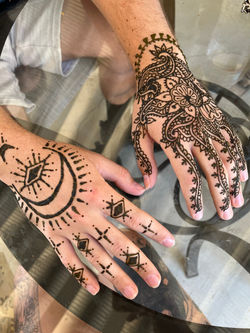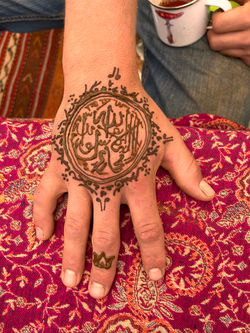
All About MUD
Henna Made Easy
LifeArt Mehndi Mud is well known by henna professionals to be safe and effective. Our henna paste is hand crafted in small batches to insure the best possible results. This starts with premium henna powder. We import our powder from small farms in Rajasthan India. It is triple sifted to insure a smooth texture. We mix the henna with fresh squeezed organic lemons and add organic soap grade eucaluptus oil. A small amount of food preservative is then added to kill any harmful bacteria. Thats it ! Our auyervedic mixing process is what sets us apart. Simple ingredients and lots of experience.







Mehndi Mud comes ready to use in 2 oz applicator bottles with choice of different tips. One two oz bottle will cover the the area equivalent to two eight and a half by eleven sheets of paper with small designs. With MUD there is no need for any additional products. Just leave it on the skin for one hour and enjoy an ten day stain. When the henna is first squeezed out of the bottle is appears green in color but as it drys on the skin it turns dark and looks black. When it is thoroughly dry it flakes off and leaves a bright pumpkin orange stain. During the next twenty four to forty eight hours it darkens to a mahogany brown and most parts of the body. The knees down and the elbows down are the easiest parts of the body to stain. Other areas may require a second coat to get the desired effect. Call for any additional questions.
 |  |  |  |  |
|---|---|---|---|---|
 |  |  |  |  |
 |  |  |  |  |
LifeArt Henna Body Art Guide
How to Apply MUD
Henna Body Art is a simple process that can be learned with a few hours of practice. The more you apply henna tattoos the more you learn about the tricks and techniques that make a seasoned artist. We will try to give you a few pointers that will help solve problems that you will encounter as you practice mehndi.
Henna should come from a natural source. Be aware when using products tat claim to be henna ink or paint. Henna is a natural red dye that will stain the skin a reddish brown to coffee color. With practice you can get a dark stain on any part of the body. It stains best from the elbows down and the knees down.
Mehndi Mud is a good way to start out and a favorite of many professional artists. We suggest starting with Mehndi Mud because it will give you the best example of how henna should work and is safe for everyone to use.
Cleaning the skin is very important. Jest because you wash the skin with soap does not make it clean enough for applying henna art. Many soaps will act a skin barrier. Alcohol is also another problem because it mixes with oils and can block the pores of the skin. The upper middle back and chest have more natural oils and special attention should be given cleaning these parts of the body. A hot bath is a good start if you plan a large design, but remember no soap.
Avoid mineral oils and suntan lotion with sunscreens will totally block the pores and must be clean. Lemon is a good cleaner as well as witch hazel. We prefer to use fresh lemon wedges as scrubby pads. Keep some fresh lemons on hand while working with henna mehndi. Do not use any oils on the skin before you apply MUD.
Applying henna is done with applicator bottles or plastic cones. We prefer the low density plastic bottles and all the different size interchangeable tips that we offer on this web site. Once in a while the smalle tips will clog. Tapping the applicator bottle on a hard surface usually will solve this problem. If that doest work force water through the tip. Keeping the tips clean is important when drawing detailed designs. It is a good idea to squirt a small amount of paste through the tips before applying the henna to avoid blobs.
Henna should be left on for as long as possible. MUD will stain fast but it is best to leave it on as long you can. You can use lemon sugar on MUD if you like, but it isn't necessary for a dark stain. The longer you leave the henna paste on the longer the design will last. One hour with MUD will leave a stain that lasts about ten days. Afte the paste is applied the body should be kept as still as possible and try not to disturb the skin. It is important to be in a nice environment where you can relax and not be distracted. This is not always possible at public events but try to keep still until the wet henna heals over as it begins to dry.
When the henna paste is thoroughly dry and ready to remove it should flake off on its own. Whatever doesn't flake off should be scraped off. A plastic card works great. It is best not to expose the fresh henna designs to water for about eight hours. Chlorine pools are particularly bad for henna. Natural plant based oils may be applied before bathing to seal in the henna and protect it from exposure to soap. These oils may slow the exfoliation process which mean the design will last longer. As the body naturally exfoliates the henna will fade.


